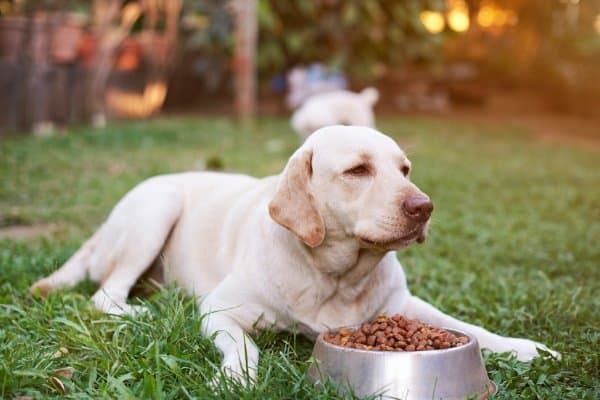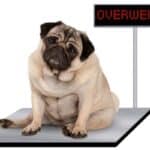According to a recent survey, a whopping 56% of American dogs are overweight or obese. That equates to approximately 50 million dogs with a weight issue.
Surprisingly, according to the same survey, only 15% of dog owners routinely weigh their pet every month, even when dealing with obesity issues. Perhaps even more shocking, by the age of 6 months, 21% of dogs are already overweight, setting themselves up for a lifelong battle against the bulge.
For nearly 30 years, Labrador Retrievers have topped the popularity charts, but they’re also one of the most likely breeds to struggle with their weight. Let’s find out why.
Why are Labradors prone to obesity? In addition to lifestyle-related causes, a variant of a gene that regulates a feeling of fullness after a meal is found in approximately one-fourth of Labradors. This variant causes affected Labs to still feel hungry even after eating and is directly associated with obesity.
Obesity can have a devastating impact on your Lab’s health. Knowledge is power, right? So let’s jump right in and take a closer look at this common Labrador issue.
Why Are So Many Labradors Overweight or Obese?
Gulping down entire meals without chewing and then begging for more, constantly scavenging for a free meal, being obsessed with food, and rummaging through the garbage for a tasty morsel. These are all very common Labrador behaviors.
If you’ve noticed that your Lab seems to be hungry all of the time and is becoming larger by the day, you’re not alone. Most Labs are incredibly food motivated and can easily grow too heavy.
Generally, when a dog is 15% or more over the ideal weight for his breed and sex, he is considered overweight, but once he surpasses 30%, he is obese. Both of these conditions can occur when the amount of energy (in the form of food) consumed is greater than the amount of energy expended.
So why do Labs seem to struggle more with this issue than other breeds? Well, new-found scientific evidence suggests the answer might be genetic.
A gene called pro-opiomelanocortin (POMC), which has been found to be linked to appetite, weight, and satisfaction after eating, lacks 14 base pairs in about ¼ of all Labrador Retrievers (and Flat-Coated Retrievers too).
Scientists discovered that the more copies of this gene variant a dog has, the more likely the dog is to become overweight and obsessed with food. In fact, dogs with just one copy of this variant were on average 4 pounds heavier than normal.
This POMC variant compromises the dog’s ability to feel full and satisfied after a meal, leaving him feeling hungry all of the time. This explains why so many Labradors are intensely food motivated (which does make training quite easy) and have a desire to eat that far exceeds their actual nutritional requirements – leading to obesity.
Other Factors That Contribute to Labrador Obesity
Aside from genetic factors, Labs have several other factors working against them when it comes to maintaining an ideal weight.
Diet
Admittedly, it’s hard to say no to a Lab’s smiling face and imploring eyes when it comes to food, but overfeeding is one of the most prevalent contributors to fat Labs. In fact, just a few extra pieces of kibble every day can turn into several extra pounds of body fat over the course of a year.
Offering too large of meals isn’t the only problem though, as feeding snacks, dog bones, and tidbits of people food throughout the day can quickly equate to added weight as well.
In addition to a lack of portion control, feeding the wrong kind of dog food can also lead to weight gain. Rich diets loaded with fat and excess calories or poor-quality kibble packed with empty calories can both enable your Lab to pack on extra pounds.
Sterilizing
When a dog is spayed or neutered, the consequent hormonal changes result in a slower metabolism and an increased appetite. If, after surgery, adjustments are not made to the dog’s diet or exercise time, weight gain may occur easily, especially during the two years immediately following the procedure according to the National Center for Biotechnology Information.
Lifestyle
Another major contributor to Labrador weight gain is the fact that the vast majority of these active dogs are not routinely doing what they were bred to do. Remember, the Labrador was created to spend long hours working alongside Newfoundland fishermen in harsh conditions and frigid waters. Those working dogs had hearty appetites but quickly burned off extra calories each day through hard work.
Today, many Labs are not given the opportunity to exercise as they should. No long hours hunting and retrieving in the field, no days spent plunging into the water to bring back downed game. The result? Extra pounds accumulate.
Age
As dogs age, they tend to naturally slow down, just like people and will spend more and more time resting and sleeping as they ease into old age. Many owners find that this is the time when their once-trim Labrador becomes a little too hefty.
Health Conditions
Certain health issues, such as hypothyroidism or Cushing’s disease, can cause unexpected weight gain and lead to obesity if not properly treated. Before any weight-management program is started, a check-up by your veterinarian is recommended to rule out any underlying diseases or disorders.
How to Tell If Your Lab Is Overweight
It’s a wise idea to evaluate your Lab’s weight once a month or so and it only takes a few moments to complete. Of course, you could bring him by your vet’s office to be weighed, but a visual check and quick feel of his bones can easily be done right at home.
View your Lab from directly overhead and from the side while he is standing up, and run your hands down his spine, over his ribcage, and across his rump, prodding gently with your fingertips for the rib, spine, and hip bones.
Signs of an overweight Labrador include:
- No noticeable indentation at the waist is present when viewed from above.
- Belly hangs down and there is no slight upward slant of the abdomen from the ribcage toward the hips.
- The rib and hip bones and the knobs of the backbone are difficult to find by gentle probing or can’t be felt at all.
- Rolls of fat are present or dog appears bloated.
Dangers of Obesity
High blood pressure, joint issues, osteoarthritis, diabetes, kidney disease, respiratory troubles, heart disease, cancer, and a general decreased quality of life are all associated with obesity. Sound familiar? These same dangers plague people struggling with obesity as well.
How to Help Your Overweight Lab Lose Weight
An ounce of prevention is worth a pound of cure, but if your Lab is already on the pudgy side, you need to take action now.
The first step in reducing your Lab’s weight should be a trip to the vet to ensure that there aren’t any major health issues to deal with first. While there, ask your vet to calculate the correct amount of daily calories your dog should be eating so that you can make adjustments right away.
Also ask about replacing a portion of his regular meals with an equal amount of canned green beans to decrease calorie consumption or switching to a kibble formulated for weight management.
In place of his usual snacks, offer only healthy treats like a baby carrot, a few blueberries, or an apple slice, and practice tough love when he looks at you like he’s starving.
Gradually increasing the amount of your Lab’s daily exercise is key to shedding extra weight. Don’t just teach him to walk on a treadmill (although you can), but make each exercise session a fun bonding opportunity.
Dinnertime can also be used to increase physical activity if instead of placing his food in a bowl, you hide it within a snuffle mat or make a trail of kibble winding through your backyard.
These activities will get him moving, slow his eating down so his tummy has a chance to realize that it’s full and will provide mental stimulation.
Last update on 2024-04-19 at 21:26 / Affiliate links / Images from Amazon Product Advertising API







